How to Reverse Insulin Resistance
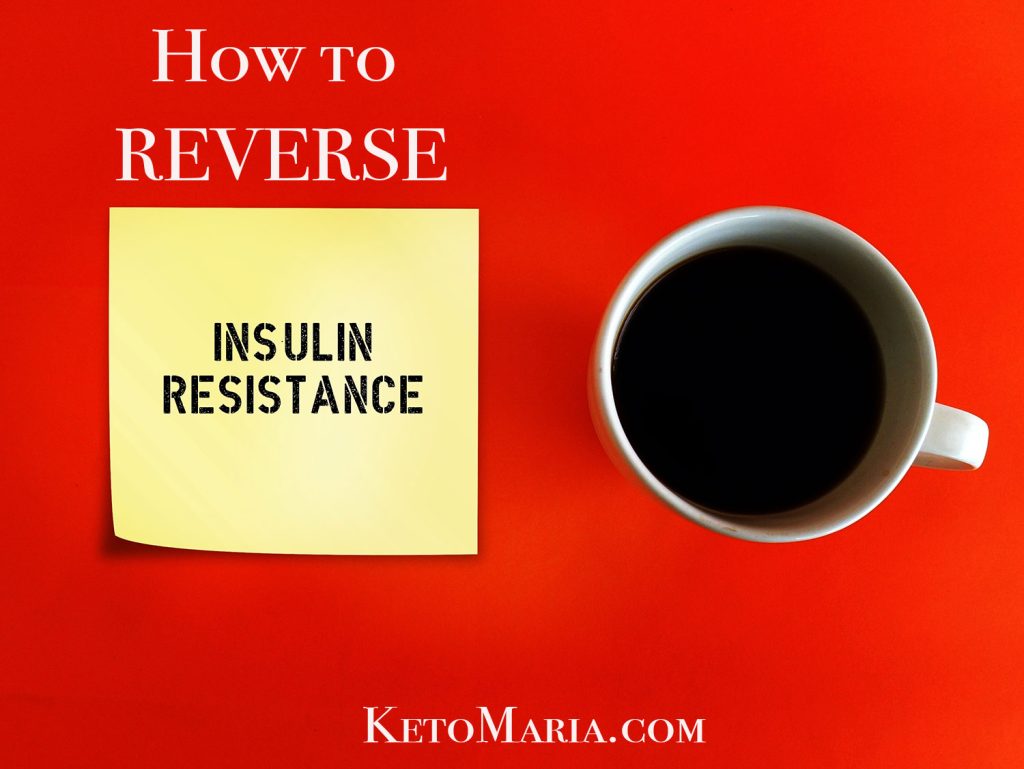
Insulin resistance effects millions of people across the globe. In this article we will break down the main root cause of insulin resistance or type II diabetes. Then we will discuss the best way to reverse insulin resistance.
What is Insulin Resistance and Metabolic Syndrome?
Insulin Resistance Symptoms:
Insulin resistance occurs when the body’s cells don’t respond effectively to insulin, a hormone produced by the pancreas that helps regulate blood sugar (glucose) levels. When this happens, several symptoms may manifest:
- Increased Hunger: Despite having eaten, individuals with insulin resistance may experience persistent hunger. The cells aren’t efficiently taking up glucose, leading to a sense of constant hunger.
- Fatigue: The cells need glucose for energy, but with insulin resistance, glucose uptake is impaired. This can result in feelings of tiredness and fatigue.
- Weight Gain: Insulin resistance is often associated with weight gain, especially around the abdominal area. The body may store more fat, particularly visceral fat, which is linked to insulin resistance. Also resulting in more fat deposits in the liver leading to fatty liver disease.
- Blurry Vision: Fluctuations in blood sugar levels can affect the eyes, causing temporary blurry vision in some individuals.
Insulin resistance is pre-diabetes (or really just the early stages of type II diabetes). It also has a cluster of symptoms related to it called metabolic syndrome. So let’s look at what metabolic syndrome is.
Metabolic Syndrome:
Metabolic syndrome is a cluster of conditions that often occur together, increasing the risk of heart disease, stroke, and type 2 diabetes. The key components of metabolic syndrome include:
- Central Obesity: This refers to the accumulation of fat around the abdomen, giving an “apple-shaped” appearance. It is often measured by waist circumference.
- High Blood Pressure: Blood pressure consistently higher than normal levels is a component of metabolic syndrome.
- High Blood Sugar: Elevated fasting blood sugar or impaired glucose tolerance is indicative of insulin resistance and can be a part of metabolic syndrome.
- High Triglycerides: Elevated levels of triglycerides, a type of fat in the blood, contribute to the metabolic syndrome profile.
- Low HDL Cholesterol: High-density lipoprotein (HDL) cholesterol is often referred to as “good” cholesterol. Low levels of HDL cholesterol are associated with metabolic syndrome.
Having three or more of these components typically leads to a diagnosis of metabolic syndrome. It’s a significant risk factor for cardiovascular diseases and type II diabetes.
There are many hypothesis for the root causes of insulin resistance and type II diabetes. Some believe it is all about the elevated insulin levels. Yes, but there is a big difference between post prandial (after eating something) insulin and basal (fasted) insulin levels. The fasting insulin levels, the amount of insulin being put out by your pancreas all day long, are far more important because they represent 80-90% of the insulin for the body (when eating low carb, keto or carnivore). Only 10-20% of the insulin output by your pancreas is for food eaten. Those that focus on insulin after meals are missing the most important insulin factor, the insulin put out all day long, when not eating which is 80-90% of the insulin your body uses in a day. We will dive into these types of insulin in a future article. But an even bigger question is this:
What if the elevated insulin levels (basal or fasting insulin) are the RESULT of another problem that is the real root cause on insulin resistance?
Side Story of Personal Fat Threshold
Before we dive into the root cause of insulin resistance, let’s talk about something unique in human physiology. When we are toddlers our body’s have the ability to make lots of new fat cells (adipose). But after we are toddlers, most of us lose the ability to make lots of new fat cells. We just fill up or empty the ones we have. This is called your Personal Fat Threshold.
This is why you can have someone who is 100 pounds overweight and has no signs of insulin resistance and someone who is 110 pounds and is fully type II diabetic and insulin resistant. The person who is 110 pounds has very few fat cells and they fill them up very quickly (which causes inflammation and insulin resistance, more on that below). The person that has 100 pounds of body fat still has a lot of fat cells that aren’t stuffed so there is still plenty of space to store more body fat. His fat cells are not all stuffed and inflamed yet.
Another important aspect of fat cells that are smaller is that they put out more adiponectin. This is important for so many reasons (more on this below). So we want small, happy fat cells regardless of how many we have on our body.
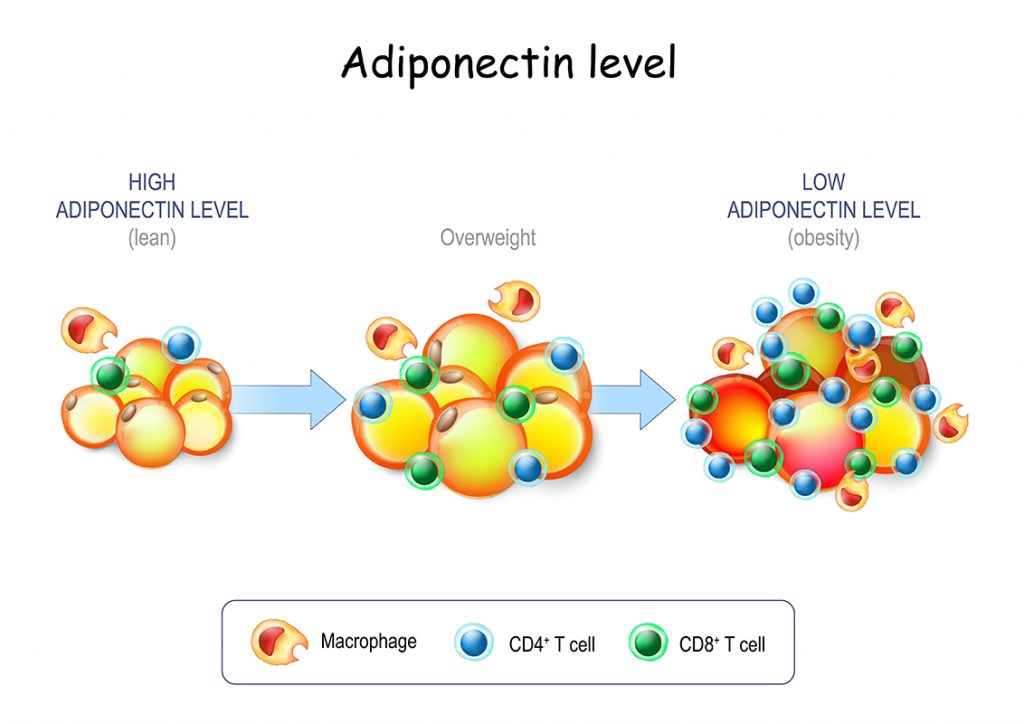
Here is a video discussing personal fat threshold in more detail:
What is the Root Cause of Insulin Resistance?
This is a complex topic that I will try to explain in an easy to understand, light hearted way because this is a very important topic for everyone to understand.
Insulin resistance might sound like a complicated puzzle, but what if I told you that the answer could be hidden in something as familiar as your fat tissue? Yup, that’s right! Let’s take a journey into the fascinating world of insulin resistance and explore why scientists are shining a spotlight on our chubby buddies – our adipose tissue.
The Big Players: Adipokines and Inflammation Ever heard of adipokines? They’re like the messengers sent out by your fat cells. One of them, adiponectin, is a bit of a superhero. It helps insulin do its job and fights off inflammation. Imagine it as insulin’s trusty sidekick. But then there’s leptin, another adipokine that, when too much is around (thanks, obesity), can make cells resist insulin (and leptin resistant). It’s like having a friend who talks too much and stops you from getting your work done! Adiponectin is a true superhero and effects all kinds of tissues and organs in the body. This chart is a sample of just some of the things adiponectin can help with.
(Source)
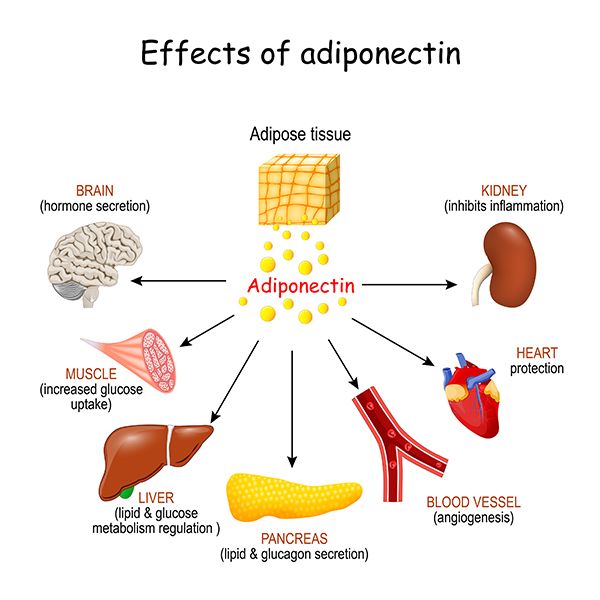
The Villain: Lipotoxicity Now, not all fats are created equal. Some fats released by adipose tissue can be troublemakers. They mess with insulin signaling, making it harder for insulin to do its job. It’s like having a villain in the story, throwing obstacles at our hero, Insulin. Having over stuffed fat cells means insulin is no longer able to hold all the fat in storage as fat cells become insulin resistant. Insulin rises higher and higher trying to force the fuel into storage but the fat cells aren’t taking it. So fat starts to accumulate in places it shouldn’t. Think high blood triglycerides, fatty liver, etc.
(Source)
The Sneaky Move: Ectopic Fat Deposition Picture this: fat cells decide to set up camp in places they shouldn’t, like the liver and muscles. This is called ectopic fat deposition. It’s like your fat cells throwing a surprise party in the wrong neighborhood. This unwanted fat messes up how insulin works, causing all sorts of trouble. Because too many of the fat cells are overstuffed and inflamed (and as a result, insulin resistant), insulin can’t drive more fat into the adipose where it wants to resulting in fat being deposited in places it shouldn’t be.
(Source)
Putting It All Together: So, here’s the scoop: our adipose tissue isn’t just a cushion for our comfort; it’s a key player in the insulin resistance game. Understanding how adipokines, ectopic fat, and lipotoxicity dance together helps us see the bigger picture.
The Takeaway: Taking care of our fat tissue is crucial for keeping insulin on our side and avoiding insulin resistance. Eating proper macros, regular exercise (especially those designed to build and maintain muscle), and keeping our fat cells happy (smaller) can go a long way in preventing insulin resistance.
In the end, it turns out that the secret to cracking the code of insulin resistance might just be hidden in the places we least expect – our fat tissue! So, let’s give our adipose tissue the love and attention it deserves!
Remember, your fat tissue might be more interesting than you thought! Here is a video that breaks these mechanisms down further.
How to Reverse Insulin Resistance
So how do we reverse insulin resistance? There are two primary ways that you can improve and reverse insulin resistance.
1 Maintain or grow muscle mass
This gives glucose more places to go. We store glucose as glycogen in our liver and muscle. The more muscle you have the more places to store glucose.
2 Shrink your fat cells (adipose)
The fat cell is where the cascade of insulin resistance starts. So shrinking the fat cells by burning off the fat stored in them (fat loss) is the best way to address the root cause. This is true for someone that is 300 pounds and insulin resistant, and someone that is 110 pounds and insulin resistant. This will restore healthy leptin levels, reduce insulin resistance, increase healthy adiponectin levels and reduce inflammation.
Doing these two things will improve your insulin sensitivity by giving glucose more places to be stored and reverse the fat cell inflammation and insulin resistance by reducing the amount of fat stored in your fat cells. Thus improving insulin signaling, raising adiponectin levels and lowering inflammation. All the things required to reverse insulin resistance.

LEARN MORE ABOUT REVERSING INSULIN RESISTANCE
Want to learn more and reverse your insulin resistance?
Join my Ultimate Weight Loss Challenge starting March 1st where you will get weekly coaching meetings, meal plans, macro targets and so much more!
Click HERE to sign up!
TESTIMONY OF THE DAY
“Hello friends! I am nearing the end of my weight loss, having lost 93 pounds following Maria and Craig. I’d like to lose the last 13 (or so, seems to be a moving target) with this challenge! I have already reversed insulin-dependent diabetes, kidney disease, neuropathy, retinopathy, hypertension, sleep apnea, and obesity-related skin conditions. My A1c went from 14+ to 4.6. My blood pressure went from 180/110 to 105/57. I was told that I was going to die in my 50s (I was 53 when told this). I am now 54 and in outstanding health with a normal life expectancy. I weigh 148 pounds, but will work hard to see 135! Pleased to make your acquaintance!” – Janet
Most people I consult are doing keto totally wrong. Get fast results with the my Mind-blowing Keto School!
Click HERE to check out my supplement plans!
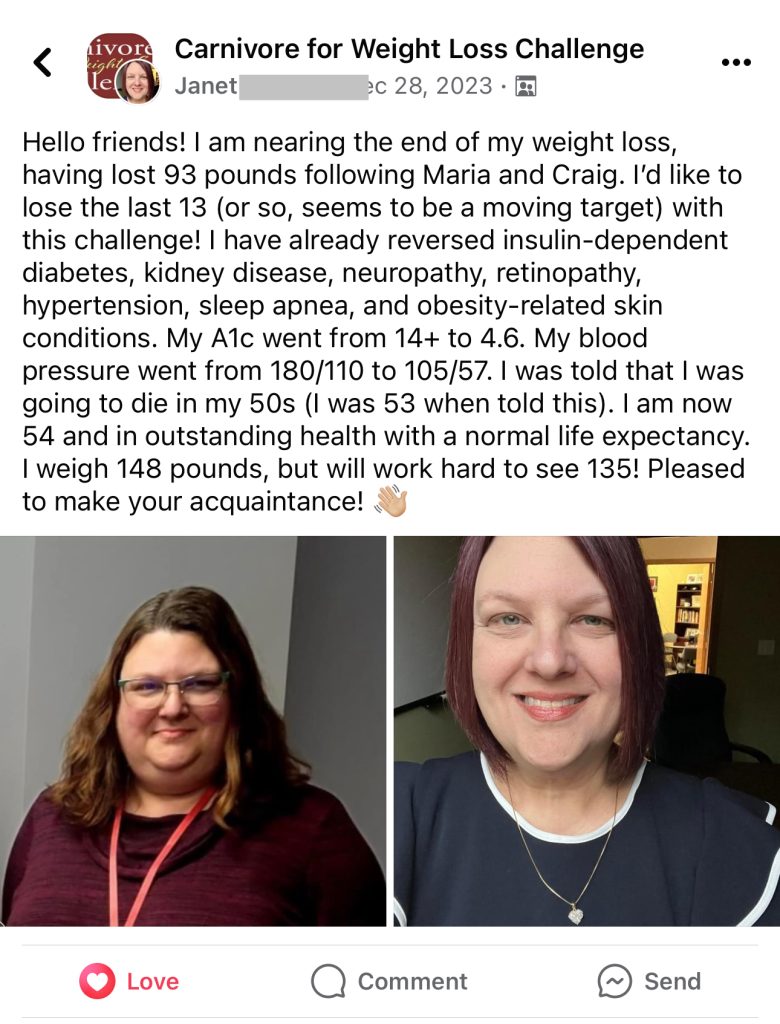









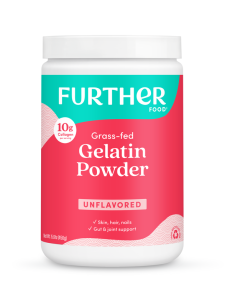

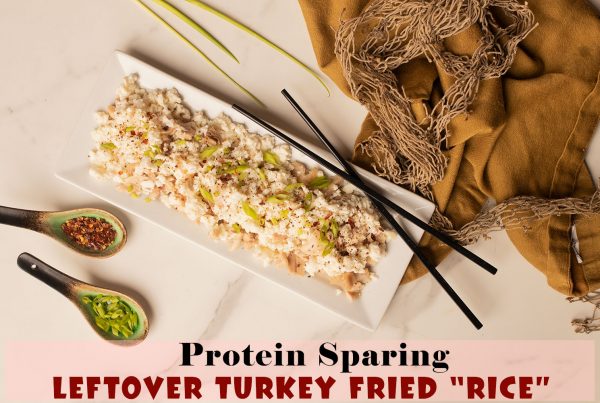


Hi Maria,
I am tryng to buy an e copy of your book Keto-Adapted. I went on Amazon and the ebook version is not available there. Can you please help me.
I live in South Africa which is why I want the ebook – postage/delivery costs are astronomical here.
Thank you for your help.
Kind regards
Sally
You can buy my ebooks here: https://keto-adapted.com/product-category/ebooks/